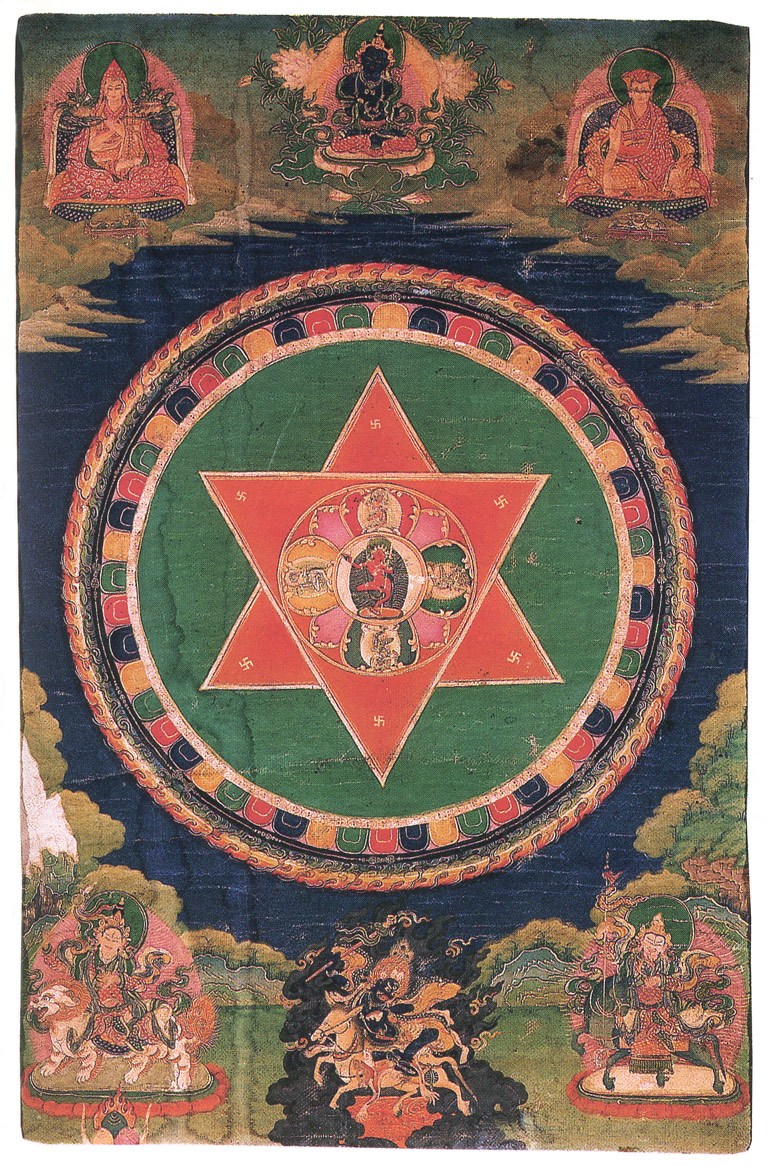|
Vairocanavajra
Vairocanavajra (also known as Vairocana and Vairocanaraksita) was a 12th-century Indian Buddhist master and alchemist who studied at the monastery of Nalanda. He is known in particular for his work in the translations of the Charyapadas which have been described as "having a lasting effect on the literary history of Tibetan Buddhism." Life Vairocanavajra's biography was written by his Tibetan student, Zhang Yudrakpa Tsöndru Drakpa, shortly after his death and was intended to be a eulogy to his master. Vairochanavajra was born in the 12th century in the city of Sonapura in the region of Dakshina Kosala which is just south of Magadha. From the age of 12, he travelled with his uncle, who was a non-Buddhist, to different parts of India including Western India, Magadha, and Varanasi. During his travels, he met a yogin who initiated him into the practice of the bodhisattva, Manjushri. After this, he travelled to the monastery of Nalanda where he studied under a yogin called Surapel ... [...More Info...] [...Related Items...] OR: [Wikipedia] [Google] [Baidu] |
Nalanda
Nalanda (International Alphabet of Sanskrit Transliteration, IAST: , ) was a renowned Buddhism, Buddhist ''mahavihara'' (great monastery) in medieval Magadha (Mahajanapada), Magadha (modern-day Bihar), eastern India. Widely considered to be among the greatest Ancient higher-learning institutions, centres of learning in the ancient world and often referred to as "the world's first residential university", it was located near the city of Rajagriha (now Rajgir), roughly southeast of Pataliputra (now Patna). Operating for almost a thousand years from 427 CE until around 1400 CE, Nalanda mahavihara played a vital role in promoting the patronage of arts, culture and academics during the 5th and 6th century CE, a period that has since been described as the "Golden Age of India" by scholars. Nalanda was established by emperor Kumaragupta I of the Gupta Empire around 427 CE, and was supported by numerous Indian and Javanese patrons – both Buddhists and non-Buddhists. Nalanda continue ... [...More Info...] [...Related Items...] OR: [Wikipedia] [Google] [Baidu] |
Abhayakaragupta
Abhayākaragupta ( Wylie: 'jigs-med 'byung-gnas sbas-pa) was a Buddhist monk, scholar and tantric master (''vajracarya'') and the abbot of Vikramasila monastery in modern-day, Bihar in India. He was born in somewhere in Eastern India, and is thought to have flourished in the late 11th-early 12th century CE, and died in 1125 CE.Nakamura, Hajime. (1980) ''Indian Buddhism: A Survey with Biographical Notes''. 1st Indian Edition (1987), Motilal Barnasidass, Delhi, p. 335. Abhayākaragupta's magnum opus, the ''Vajravali'', is a "grand synthesis of tantric liturgy" which developed a single harmonized tantric ritual system which could be applied to all Tantric Buddhist mandalas. According to A.K. Warder, Abhayākaragupta developed the Mantrayana-Madhyamaka doctrine to its final Indic form. Matthew Kapstein sees him as "among the last great masters of Buddhism in India." Life Some Tibetan sources identify his birthplace as ''Jarikhanda'' which Taranatha places next to Odisha. Gudr ... [...More Info...] [...Related Items...] OR: [Wikipedia] [Google] [Baidu] |
Dakshina Kosala
Dakshina Kosala (IAST: Dakṣiṇa Kosala, "southern Kosala") is a historical region of central India. It was located in what is now Madhya Pradesh and Chhattisgarh along with parts of Western Odisha. At its greatest extent, it may have also included a part of the Vidarbha region in present-day Maharashtra. Its capitals at various times included Bhadravati, Sirpur (ancient Shripura), Tuman (ancient Tummana), and Ratanpur (ancient Ratnapura). Extent Dakshina Kosala ("South Kosala"), sometimes simply called Kosala, is hard to distinguish it from Uttara Kosala ("North Kosala") in present-day Uttar Pradesh. Epigraphic evidence suggests that the area bounded by the Shahdol, Raipur, Bilaspur, Anuppur Sambalpur districts was definitely a part of the Dakshina Kosala region. The inscriptions found in these districts record grants of villages located in the Kosala country, and the rulers mentioned in these inscriptions are given the titles indicating their lordship over Dak ... [...More Info...] [...Related Items...] OR: [Wikipedia] [Google] [Baidu] |
Arts
The arts or creative arts are a vast range of human practices involving creativity, creative expression, storytelling, and cultural participation. The arts encompass diverse and plural modes of thought, deeds, and existence in an extensive range of List of art media, media. Both a dynamic and characteristically constant feature of human life, the arts have developed into increasingly stylized and intricate forms. This is achieved through sustained and deliberate study, training, or theorizing within a particular tradition, generations, and even between civilizations. The arts are a medium through which humans cultivate distinct social, cultural, and individual identities while transmitting values, impressions, judgments, ideas, visions, spiritual meanings, patterns of life, and experiences across time and space. The arts are divided into three main branches. Examples of visual arts include architecture, ceramic art, drawing, filmmaking, painting, photography, and sculpture. ... [...More Info...] [...Related Items...] OR: [Wikipedia] [Google] [Baidu] |
Vajravārāhī
In Tibetan Buddhism, Vajravārāhī ("The Indestructible Sow", Dorje Pakmo) is considered a female buddha and "the root of all emanations of dakinis". As such, Vajravarahi manifests in the colors of white, yellow, red, green, blue, and black. She is a popular deity in Tibetan Buddhism, and in the Nyingma school she is the consort of Hayagriva, the wrathful form of Avalokiteshvara. She is also associated with the ''Cakrasaṃvara Tantra'', where she is paired in yab-yum with the Heruka Cakrasaṃvara. The Vajravarahi tulku lineage is the Samding Dorje Phagmo, who are associated with the Bodongpa, a little-known school of Tibetan Buddhism. There are practices of Vajravārāhī in all schools of Tibetan Buddhism, and in the Kagyu school Vajravarahi is one of its main yidam practices. Vajravarahi is depicted as a naked, often red-skinned maiden in a dancing posture, with a kapala (skull cup) in her left hand and a khatvanga on her left shoulder, while her right hand holds ... [...More Info...] [...Related Items...] OR: [Wikipedia] [Google] [Baidu] |
Tummo
In Tibetan Buddhism, ''tummo'' (; ) is the fierce goddess of heat and passion. Tummo is found in the Mahasiddha Krishnacarya and the '' Hevajra Tantra'' texts. Tummo is also a tantric practice for inner heat, developed around the concept of the female deity. It is found in the Six Dharmas of Naropa, Lamdre, Kalachakra, and Anuyoga teachings of Vajrayana. The purpose of tummo is to gain control over body processes during the completion stage of Anuyoga or Anuttarayoga Tantra ('highest yoga tantra'). The practice begins by visualizing the body's energy channels, winds, drops, and chakras. Inner heat, generated through specific breath-holding exercises, helps vital winds enter the central channel, leading to blissful experiences. The practice also involves focusing on seed syllables at the chakras and combining them with meditation on emptiness. Over time, practitioners aim to master this process, achieving heightened states of clarity, inner heat, and bliss. Scientifi ... [...More Info...] [...Related Items...] OR: [Wikipedia] [Google] [Baidu] |
Tibet
Tibet (; ''Böd''; ), or Greater Tibet, is a region in the western part of East Asia, covering much of the Tibetan Plateau and spanning about . It is the homeland of the Tibetan people. Also resident on the plateau are other ethnic groups such as Mongols, Monpa people, Monpa, Tamang people, Tamang, Qiang people, Qiang, Sherpa people, Sherpa, Lhoba people, Lhoba, and since the 20th century Han Chinese and Hui people, Hui. Tibet is the highest region on Earth, with an average elevation of . Located in the Himalayas, the highest elevation in Tibet is Mount Everest, Earth's highest mountain, rising above sea level. The Tibetan Empire emerged in the 7th century. At its height in the 9th century, the Tibetan Empire extended far beyond the Tibetan Plateau, from the Tarim Basin and Pamirs in the west, to Yunnan and Bengal in the southeast. It then divided into a variety of territories. The bulk of western and central Tibet (Ü-Tsang) was often at least nominally unified under a ser ... [...More Info...] [...Related Items...] OR: [Wikipedia] [Google] [Baidu] |
Western Xia
The Western Xia or the Xi Xia ( zh, c=, w=Hsi1 Hsia4, p=Xī Xià), officially the Great Xia ( zh, c=大夏, w=Ta4 Hsia4, p=Dà Xià, labels=no), also known as the Tangut Empire, and known as Stein (1972), pp. 70–71. to the Tanguts and Tibetans, was a Tangut-led imperial dynasty of China that existed from 1038 to 1227. At its peak, the dynasty ruled over modern-day northwestern China, including parts of Ningxia, Gansu, eastern Qinghai, northern Shaanxi, northeastern Xinjiang, and southwest Inner Mongolia, and southernmost Outer Mongolia, measuring about . The capital of Western Xia was Xingqing (modern Yinchuan); another major Xia city and archaeological site is Khara-Khoto. Western Xia was annihilated by the Mongols in 1227. Most of its written records and architecture were destroyed, so the founders and history of the empire remained obscure until 20th-century research in China and the West. Today the Tangut language and its unique script are extinct, only ... [...More Info...] [...Related Items...] OR: [Wikipedia] [Google] [Baidu] |
Madhyamaka
Madhyamaka ("middle way" or "centrism"; ; ; Tibetic languages, Tibetan: དབུ་མ་པ་ ; ''dbu ma pa''), otherwise known as Śūnyavāda ("the Śūnyatā, emptiness doctrine") and Niḥsvabhāvavāda ("the no Svabhava, ''svabhāva'' doctrine"), refers to a tradition of Buddhist philosophy and practice founded by the History of Buddhism in India, Indian Buddhist monk and philosopher Nagarjuna, Nāgārjuna ().Wynne, Alexander (2015) ''Early Buddhist Teaching as Proto-śūnyavāda.'' Journal of the Oxford Centre for Buddhist Studies, 6. pp. 213-241. The foundational text of the Mādhyamaka tradition is Nagarjuna, Nāgārjuna's ''Mūlamadhyamakakārikā'' ("Root Verses on the Middle Way"). More broadly, Madhyamaka also refers to the ultimate nature of phenomena as well as the non-conceptual realization of ultimate reality that is experienced in Buddhist meditation, meditation. Since the 4th century CE onwards, Madhyamaka philosophy had a major influence on the subsequent d ... [...More Info...] [...Related Items...] OR: [Wikipedia] [Google] [Baidu] |
Prajnaparamita
file:Medicine Buddha painted mandala with goddess Prajnaparamita in center, 19th century, Rubin.jpg, A Tibetan painting with a Prajñāpāramitā sūtra at the center of the mandala Prajñāpāramitā means "the Perfection of Wisdom" or "Transcendental Knowledge" in Mahayana, Mahāyāna. Prajñāpāramitā refers to a perfected way of seeing the Ontology, nature of reality, as well as to a particular body of Mahayana sutras, Mahāyāna scriptures (sūtras), known as the Prajñāpāramitā sutras, which includes such texts as the Heart Sutra and Diamond Sutra. The word ''Prajñāpāramitā'' combines the Sanskrit words ''Prajñā (Buddhism), prajñā'' "wisdom" (or "knowledge") with ''pāramitā'', "excellence," "perfection," "noble character quality," or "that which has gone beyond," "gone to the other side," "Transcendence (philosophy), transcending." Prajñāpāramitā is a central concept in Mahāyāna Buddhism and is generally associated with ideas such as emptiness (''ś� ... [...More Info...] [...Related Items...] OR: [Wikipedia] [Google] [Baidu] |






